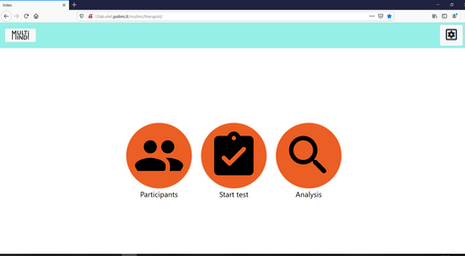Secondment at “Politecnico di Milano”: Tutoring in the course “Advanced User Interfaces”
- MultiMind

- Mar 17, 2020
- 4 min read
Updated: Mar 15, 2021
(cooperation with Prof. Franca Garzotto, Francesco Vona and colleagues from i3Lab, Politecnico, Milan)
Post by Maren Rebecca Eikerling (IRCCS - Associazione La Nostra Famigli 'Istituto scientifico Eugenio Medea')
From October 2019 to January 2020, I did my part-time secondment at “Politecnico di Milano”, a university specialized in the field of technology based in Milan. Along with PhD students and post-docs from the Politecnico-based i3Lab (Innovative Interactive Interfaces Laboratory), Department of Electronics, Information and Bioengineering, I was a tutor in the project course “Advanced User Interfaces”. Twice a week I met a group of students during class or in the lab to work together on the project that was assigned to them: building the open-source web-app, that we can use for the implementation of our multilingual screening batteries to identify the risk of developmental dyslexia/language disorders in bilingual children. The idea to build a web-app instead of a native app that can be locally installed on devices and used also offline was based on the idea to make the web-app accessible independently of operating systems (e.g. Windows vs. iOS).
The group of 8 master students consisted of designers, web-designers and programmers coming from 4 different countries using 3 different writing systems – the MultiMind spirit of interdisciplinarity and multilingualism was absolutely met and we learned a lot from each other. Since the field of language research and disorders was totally new to the students, the idea of creating tests to be used in clinical contexts was very different from projects they had been working on before (i.e. creating entertaining games for children). At the same time, I learned a lot about the logic that needs to be applied to build an app, about how many layers there are behind displaying the tasks and about the various steps to be followed to create the different parts of the web-app: therapist/admin interface and the actual test to be carried out on the computer/tablet with the children. This also meant, that sometimes we were walking a thin line between paradigms that seem to be most revealing for the identification of a risk of developmental dyslexia/developmental language disorders in bilingual children and paradigms that allow for a simple solution in terms of implementation in the web-app.

Since the project in which I am working on the development of screening batteries for different language pairs is still ongoing, we decided to create a web-app that allows for modification over time. This means that while stimuli for some screening batteries are still under development, we can start using the system with the sets of tasks that are ready to use and add others later. There are two different versions to assess the system: While the “admin” is enabled to upload stimuli (audios, pictures and writings), to create items (e.g. stimulus: audio, target/distractors: pictures) and to combine them into sets of tasks, the “therapist” can play the test without beingable to modify them, manage basic anamnestic data of the participant (in-/exclusion criteria, age, gender, languages spoken) and access the results of the tasks performed. The performance of the child in the screening is evaluated through response time and accuracy that is automatically stored for each single items, but is also accessible in an aggregated form (mean reaction time, X out of Y items correct) for research purposes.
For the tasks that were performed using E-Prime in previous data collections (i.e. judgement, self-paced reading, matching tasks) the implementation into the web-app allowing for the creation of more tasks in the course of the project was not always easy but pretty straightforward. By contrast, the implementation of automatic speech recognition systems for nonword repetition tasks and dynamic assessment (learning novel words/letters) to evaluate the amount of input required before being able to recognize and produce the novel words/letters was more demanding.
My task was to introduce my project and its goals to the students and explain how they would be contributing. Despite their thorough understanding of the technological aspects, unfortunately we didn’t have enough time to deepen their knowledge on language & reading disorders and bilingualism right from the start. In the end, this sometimes turned out to be a difficulty when implementing the tasks into the app and designing the interface. This meant that while developing the web-app, more and more relevant information on the topics of bilingualism and language & reading disorders were revealed and the tasks and interface were modified accordingly. Explaining the rationale and goals of the project along the implementation actually turned into some teaching experience for me. Besides those content-wise doubts, there were also some technical demands that could not be immediately met. Apart from the speech recognition also the looping for the dynamic assessment tasks was challenging.
Even though the system already gives a lot of flexibility to the admin in terms of item, task and test creation, there are still some constraints. I am very happy about the collaboration with Politecnico to be ongoing - within the next months we will work closely together: through experience during current piloting of the web-app, I will be able to provide feedback which will result in modification and improvement of the web-app on the long-term.
I gained experience in teaching and also addressing demands and needs very clearly. Choosing a way to implement the tasks chosen for the screenings into the web-app, I actually got to look at them from a new perspective. In general, it was very helpful to look at the whole project from the students point of view, having to question and explain all the decisions taken so far.
I would like to thank all the students for their endless effort and Franca, Francesco and their colleagues from the HocLab for having given us the chance to create this web-app and for their big support!











Comments